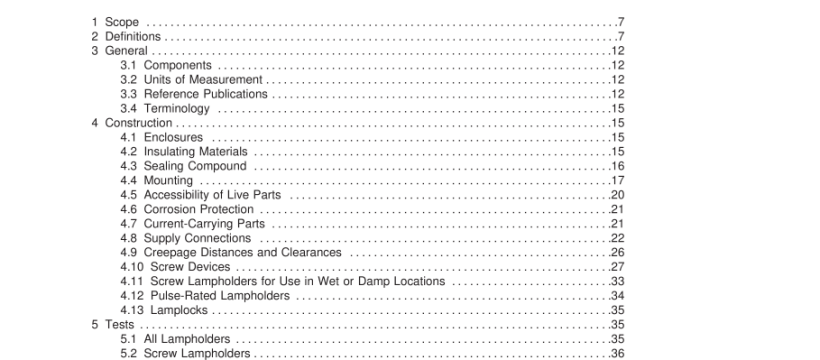UL 496-2008 pdf download.Lampholders.
1 .3 These requirements also cover holders for automatic starters used with fluorescent lamps. 1 .4 These requirements also cover GU24 and GU24-1 holders for fluorescent self-ballasted lamps and fluorescent lamp adapters with mating pin bases. 1 .5 These requirements also cover indicator lamps. 1 .6 These requirements also cover lampholder inserts. 1 .7 These requirements also cover naval-use lampholders. See Supplement SB. 1 .8 These requirements do not cover fluorescent self-ballasted lamps and fluorescent lamp adapters covered in UL 1 993. 1 .9 These requirements do not cover seasonal-lighting lampholders, which are covered in UL 588, and CSA C22.2 No. 37. 1 .1 0 These requirements do not cover electrode receptacles for use in gas-tube signs, which are covered in UL 879 and CSA C22.2 No. 34. 1 .1 1 These requirements do not cover devices requiring a cross-bar, mounting strap, or other mounting means; such devices are considered to be luminaires. 1 .1 2 These requirements do not cover nightlights, which are covered in UL 1 786 and CSA C22.2 No. 256. 2 Definitions 2.1 For the purpose of this standard, the following definitions apply: 2.2 Actuating member – the part of a switch actuator that extends outside the body and is exposed to contact by the user.
2.7 Center contact – a contact used in a screw lampholder to engage the center contact of a lamp base. 2.8 Current tap – an adapter that is screwed into a base-supply lampholder and provides multiple outlets of the lampholder or slotted receptacle type. 2.9 Damp location – an interior or exterior location that is normally or periodically subject to condensation of moisture. Damp locations include partially protected locations under canopies, roofed open porches, and similar locations. 2.1 0 Device screw base – a cylindrical component of a screw device having an external male thread or form for engaging a corresponding lampholder. 2.1 1 Dry location – a location not normally subject to dampness. Dry locations include locations subject to temporary dampness, as in the case of a building under construction, provided ventilation is adequate to reduce the likelihood of accumulation of moisture. 2.1 2 Enclosure – that part or parts of a lampholder that: a) renders inaccessible all or any parts of the equipment that may otherwise present a risk of electric shock, or b) retards propagation of flame caused by electrical disturbances occurring within. 2.1 3 General-use – suitable for direct installation in the field.
2.39 Lampholder, screw-ring – an externally threaded lampholder intended for mounting in a panel opening by means of a threaded ring. 2.40 Lampholder, seasonal-lighting – a lampholder that is restricted for use with Christmas-tree and decorative lighting outfits and which by its construction and application is not suitable for general use. 2.41 Lampholder, skeleton-type – a screw lampholder that does not use conductive screwshell threads to make electrical contact with the lamp screw base. Electrical contact with the lamp screw base is made with one or more separate contacts in the side wall of the lamp cavity or a ring contact in the bottom of the lamp cavity. 2.42 Lampholder, temporary use – a lampholder intended for installation and use in accordance with Article 527 of the National Electrical Code, ANSI/NFPA 70, and Section 76 of the Canadian Electrical Code, Part I, C22.1 . 2.43 Lampholder, weatherproof – a lampholder intended for direct exposure to the weather. 2.44 Lamplock – a feature intended to keep a lamp from being removed except by a person having a key or special tool. 2.45 Lining – an intermediate piece of insulating material constructed to prevent electrical contact between live parts, such as the screwshell, and the outer shell, cap, or cover. 2.46 Live part – a part that is energized during normal operation. 2.47 Normal hand tools – any standard American or metric wrench or screwdriver (straight blade, Phillips (cross point) or Robertson head (square)). 2.48 Ratcheting mechanism – a device mechanism that does not permit removal of the lamp or lamp adapter.UL 496-2008 pdf download.
UL 496-2008 pdf download
